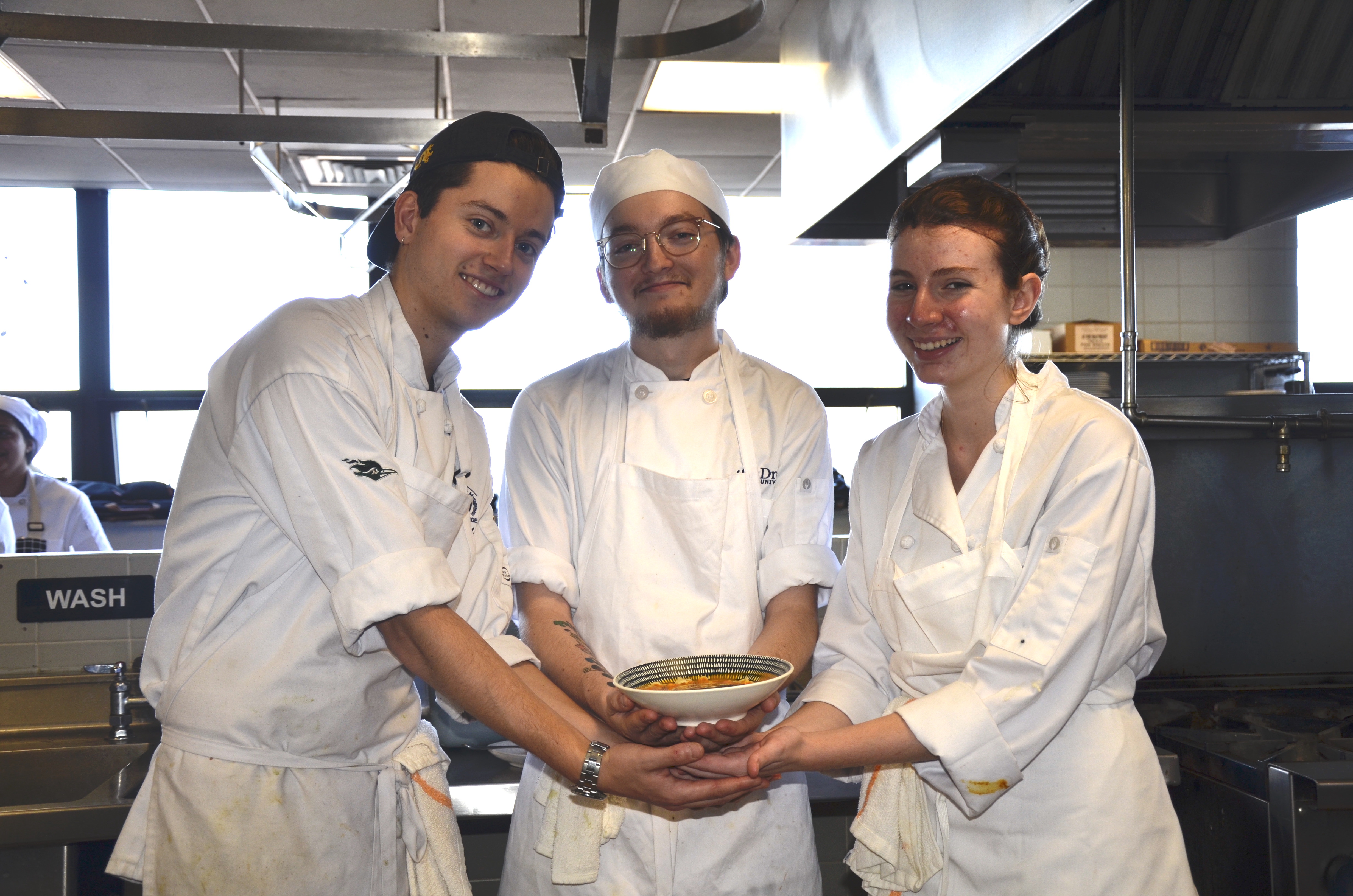One partner, so many opportunities
Collaboration between Drexel University and Longwood Gardens prompts new courses, exhibits and cutting-edge research
By: Natalie Kostelni
May 26, 2023
Late last October, a team of researchers from Drexel University descended upon Longwood Gardens wearing high-tech headwear and other gear as part of an innovative study to measure the degree to which our brain responds to nature.
The headwear was mobile neuroimaging technology referred to as functional near-infrared spectroscopy (fNIRS). These portable devices allow researchers to move their work out of the lab and into real-world environments such as Longwood.
 Students using FNIR technology
Students using FNIR technology
Using the fNIR technology, the team of graduate and undergraduate researchers collected and recorded brain activity and other wearable biomedical sensors measured physiological activity such as heart rate and electrical properties of the skin as participants walked around Longwood. An emerging interdisciplinary research field, neuroergonomics, seeks to study the brain’s health and performance in real world environments.
“We want to understand human brain function, its relation to complex behavior, and in its natural, everyday life environment,” said Hasan Ayaz, PhD, associate professor at Drexel’s School of Biomedical Engineering, Science and Health Systems and at the College of Arts and Sciences.
“Existing studies with traditional approaches have accumulated overwhelming knowledge but are limited in scope such as being only in artificial lab settings and with simplified tasks,” Ayaz said. “Mobile neuroimaging enables going out of lab, continuous measurement of brain function in increasingly realistic and real settings within relevant everyday life context and hence allows studying natural cognition with practical applications.”
Researchers will use data from neuroimaging to better understand and measure the impact of the experience of natural beauty on someone visiting Longwood. It’s an area of research that hasn’t been explored before.
The project is one of a series between Drexel and Longwood that began during the pandemic and continues today. The collaboration between Drexel and Longwood, facilitated by the Drexel Solutions Institute, underscores how the University’s work with external partners is often multidimensional.
In addition to research projects, the relationship between Drexel and Longwood has led to several courses that have provided students an opportunity to bridge classroom theory with hands-on opportunities to work on real-world problems, gaining skills and insights that build a robust educational experience. Thus far, nearly one hundred graduate and undergraduate students from seven of Drexel’s schools and colleges have contributed to the research projects or participated in courses and other projects with Longwood since 2020.
For Longwood, the experience has brought fresh takes on its offerings and pushed the organization into unconventional areas.
“It has been clear that there is a lot of potential. Each step we have taken with Drexel has led to new ideas, and that has been invigorating for everyone,” said Lea Johnson PhD, associate director of land stewardship and ecology at Longwood. Johnson chairs a committee that oversees projects between Drexel and Longwood.
As with so many other organizations, the pandemic forced Longwood to reconsider the way it had traditionally operated. The internationally renowned gardens in Kennett Square closed under government mandates in March 2020.
Longwood’s raison d'être is to share its gardens. Without the ability to have guests mill about its six distinct districts, Longwood recognized it needed to find new ways to reach a broader audience.
“We know people are healthier when they experience being in nature,” said Paul B. Redman, president and CEO of Longwood Gardens and a member of the Solutions Institute advisory board. “If we can find new ways to share nature with those who don’t have ready access to it and do it in a meaningful way such as through virtual reality to bring it to life for them, we think we can help people.”
 Jonathan Deutsch, PhD, instructing students for the Garden to Table Cooking elective (Photo: Jeff Fusco)
Jonathan Deutsch, PhD, instructing students for the Garden to Table Cooking elective (Photo: Jeff Fusco)
The desire to bring the beauty of Longwood to those who can’t easily visit led to the first collaboration with Drexel, which involved using augmented virtual reality to create an immersive, virtual experience of the conservatories, fountains, and other areas. As part of that, the Drexel team developed a learning module using virtual elements to enhance Longwood’s K-12 educational programming.
Two new courses also came out of the collaboration.
The first was an elective, Garden to Table Cooking, taught last summer by Jonathan Deutsch, PhD, program director of food entrepreneurship and innovation and professor of food and hospitality management professor in the College of Nursing and Health Professions. Students in Drexel’s Culinary Arts program as well as those majoring in business, engineering and arts were enrolled in the course, and were exposed to various aspects of Longwood’s restaurant operations. They capped the term off by creating dishes using produce grown at Longwood, with Longwood’s restaurant manager, Ryan Bloome, on hand to taste their work.
The other course, Metaverse in the Real World, was taught during the winter term by Nick Jushchyshyn, associate professor and program director of the Digital Media & Virtual Production program and the Animation, Capture & Effects Lab at the Antoinette Westphal College of Media Arts & Design.
This class included guest lectures by Neville Vakharia, associate professor in the Arts Administration & Museum Leadership program, and Raj Suri, senior vice provost for academic industry partnerships. Suri also oversees the Innovation Engine, which bolsters experiential learning by bringing students, faculty and industry partners together in the classroom and research labs to tackle complex problems that relate to the real world.
The class of 26 students learned about augmented and virtual reality tools and used them to explore new ways for visitors to engage and experience the historic Peirce-du Pont House. For their final projects, students presented before a panel from Longwood, which included Morgan Cichewicz, senior graphic designer and a 2012 Drexel graduate.
 Students presenting for the Metaverse in the Real World course
Students presenting for the Metaverse in the Real World course
“It was very cool to see Longwood Gardens as a real-world case-study for students to explore and experiment with new technologies,” Cichewicz said. “Legacy and innovation are strong ties between Drexel and Longwood.”
Luca White-Matthews, a senior graduating this year from the Pennoni Honors College with a custom designed major focused on problem solving and complex systems, said he was drawn to the course because it focused on the real world and liked the idea of undertaking a “consulting-style project” using a new technology.
“The class was really, really cool, super educational and a really good example of what is uniquely valuable about Drexel,” he said. “What you do is engage in the real world and do it in a way that is multidisciplinary. With this class, you learned about the tools and concepts and explored them and then treated the class like a lab and the project like an experiment. That is the unique value of Drexel. It was a great way to end my college career.”
Jushchyshyn has since delved into another project with Longwood that involves creating a virtual exploration of the history of the Peirce-du Pont house.
“Longwood partnered with the John Milner Architects to conduct a comprehensive study of the history and development of this home as it transformed over nearly 300 years from a modest farmhouse in 1730 into the impressive structure seen today, complete with its own botanical conservatory,” Jushchyshyn said. “This project has enabled our students to collaborate directly with historians, curators and designers, while learning and utilizing advanced technologies such as LiDAR and photogrammetry to create an entirely new exhibit for Longwood that will visually share the story of this home in a new and engaging way.”
 Dress sketches designed for A Longwood Gardens Christmas
Dress sketches designed for A Longwood Gardens Christmas
In another example of the multifaceted, interdisciplinary collaboration, Longwood also engaged Drexel’s fashion program in the Westphal College of Media Arts and Design to produce two horticulturally inspired gowns for its annual holiday display. Thirteen students in graphic design, fashion design, product design, and design and merchandising majors created the gowns. Led by Department Head of Art and Art History Sarah Steinwachs, the elaborate dresses were viewed by 540,000 visitors to Longwood during its annual holiday display.
The project between Longwood and Drexel that aims to measure how the mind responds to nature is ongoing and involves multiple components.
“The conversations with leadership at Longwood Gardens started with their need to develop a deeper understanding of how diverse visitors at the garden enjoyed Longwood’s beauty and its various assets and how such experiences impacted them when visiting in person or virtually,” Suri said. “Examining this issue from multiple perspectives not only brings various research approaches and fields together but also provides both researchers and student learners an opportunity to create impact by applying knowledge and insights from different fields in interdisciplinary settings.”
The Drexel team working on it includes faculty and undergraduate students from LeBow College of Business, the School of Biomedical Engineering, Science and Health Systems, the School of Education, and Westphal College of Media Arts & Design. The research also involves evaluating the differences between an onsite visit and virtual garden experience. To do that, the same subjects who toured Longwood last fall will wear neuroimaging sensors while walking on a treadmill and viewing a virtual reality version of Longwood Gardens back in the lab.
 (From left to right) Gabe Thayer, Zach Kaczor and Naomi Bass displaying their culinary creation in the Garden to Table Cooking elective
(From left to right) Gabe Thayer, Zach Kaczor and Naomi Bass displaying their culinary creation in the Garden to Table Cooking elective
“Longwood is a little different than some other organizations,” Redman said. “While, yes, we’re a business at the end of the day, the primary return is to inspire people and to do that through beauty and nature. Measuring the impact of that experience has never been done before because it’s very difficult to measure. By having this information, it will empower us and give us new tools to make better informed decisions when it comes to garden design, how we structure interpretive experiences onsite, online and virtually. It empowers us and gives us the tools to tell the story of how we are making a difference in the lives of the people in our community and other guests. This is so important for so many reasons. For example, when we meet with a donor and we tell them we are bringing joy to the world, we can say: Here’s the impact of that and it is measurable.”
Ayaz, Aroutis N. Foster PhD, who is associate dean of academic affairs and graduate studies and other on the Drexel team who worked on the initial Longwood experiment already presented initial results in multiple conferences earlier this year and published a paper in Applied Human Factors and Ergonomics International 2023 Proceedings titled “Evaluating the restorative impact of nature through multimodal mobile sensing of neural, physiological, and behavioral activity in ambulatory settings.”
The paper confirmed the benefits of nature on a person’s wellbeing while proposing the next step in the team’s work: to investigate “the inter-relationship of psychological, neural, and peripheral responses to nature immersion with an eye towards understanding how these may be beneficial to society at large.”
Drexel Solutions Institute is the gateway for industry, nonprofits, foundations, government entities and other organizations to connect with Drexel University and its vast expertise and resources as an R1 research institution. It manages the relationship and projects between Longwood and Drexel.